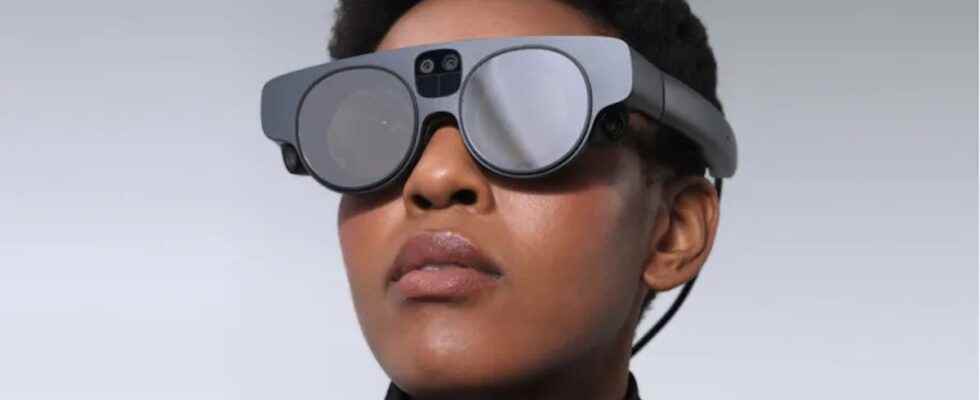Picture: Magic Leap 2.
According to Peggy Johnson, CEO of augmented reality hardware maker Magic Leap, it will likely be five years before we see a viable market for consumer use of augmented reality.
“If I had to give an estimate, I think it might take about five years for the type of fully immersive augmented reality that we are doing,” said Peggy Johnson during a recent question and answer session. live on Zoom, hosted by the Collective[i] Forecast.
Magic Leap, which pioneered the development of glasses that allowed a user to see objects rendered in their field of vision, thrilled audiences in 2018 with teaser videos. The company has also received billions of dollars in funding from Google.
A more attractive professional market
But the first version of the product released that year, a headset that sold for $2,295, disappointed. If CNET then qualified it as the best augmented reality device so far, it especially deplored “significant disadvantages”.
Peggy Johnson took over in August 2020, after spending many years at Microsoft and chip giant Qualcomm. It repurposed the Magic Leap, originally a consumer headset, into a product aimed at professional users. This is how it became “the most immersive augmented reality headset for businesses”, in the words of the company.
A second version of the helmet was launched in September, with a significantly increased price. The goal is to expand enterprise use of the product through partnerships and reseller channels.
This second version of the Magic Leap comes as the market for augmented reality and mixed reality – which mixes augmented reality and virtual reality – in business is starting to get crowded. Among its competitors, we can list the HoloLens from Microsoft, probably the best known, but also the glasses from Vuzix and Lenovo and the Glass Enterprise 2 from Google.
An improved, but perfectible V2
The Magic Leap 2 initially received favorable reactions. According to CNET’s Scott Stein, who was a reviewer in 2018, the improvements in the second version are significant. They are “a small step, but a key step for a company that, like many others, aims to solve the puzzle of augmented reality glasses”.
One of the first reviewers of the final product, Devindra Hardawar, last month called this second version a “significant achievement”.
The helmet “is easier to wear, much more powerful and offers a considerably larger (and higher) augmented reality field of vision than any other helmet available before”, he describes, before specifying that it “should be easier to use for developers, thanks to a new operating system based on Android”.
Technical progress needed for the future
However, much more fundamental technical progress is needed to achieve a “consumer-friendly” device, admits Peggy Johnson. “I think it’s necessary for such a device to be super light,” she says, adding that it should “look like glasses.”
The Magic Leap 2 is connected to a processor box attached to the belt. However, this device is not suitable for the general public, recognizes Peggy Johnson. However, “the Magic Leap 2.0 has gone a long way by becoming lighter: its weight has been reduced by approximately 20% and its size by half. We really reduced those characteristics.” And it was useful for professionals to use it “all day in an industrial environment, or even for a doctor during a long operation,” she says.
But still, for walking around, “I think the device isn’t quite what a user could sustain for an entire day. I think we really need to focus on getting into the eyewear category,” notes the CEO.
The limits of electronics
The manufacture of such a compact device comes up against the limits of current electronics, and in particular batteries. “It is difficult to go down to this size. The battery is a constraint. For now, the processor is separate from the headset, so the headset is so light it hangs on your belt or pocket. It’s a bit heavier, and the processor can get hot. We don’t think it makes sense to integrate it into the helmet at this time. It’s uncomfortable. There are others on the market that have, and that’s the biggest complaint: it’s bulky, it’s hot, it’s heavy. And so, we have to solve all of this so that users can benefit from it,” says Peggy Johnson.
An engineer by training, the CEO of Magic Leap believes that the further integration of silicon into chips will be useful: “The other big thing that will happen over time is the same thing that happens in mobile phones. , namely the integration of silicon. The CPU that powers our cell phones used to have many components, and it was bigger. And my old company, Qualcomm, is putting more and more features into this chip. This makes it possible to have a very small and light device, and a very energy efficient device. And we continue to follow this trajectory. »
In summary, Peggy Johnson believes that for this fully immersive augmented reality experience to really reach the general public, “it will take several years. Probably five years or more”.
Source: ZDNet.com
